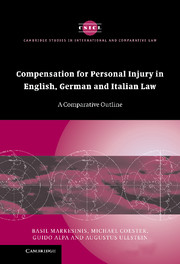Book contents
- Frontmatter
- Contents
- Foreword
- Preface
- Table of cases
- List of Abbreviations
- 1 Introduction
- 2 General damages: non-pecuniary losses
- 3 Special damages: past losses
- 4 Future pecuniary losses
- 5 Collateral sources of revenue: subrogation rights and miscellaneous matters
- 6 Conclusions
- Appendix: Comparative tables on the evaluation of physical injury (IP) for micro-permanent injuries
- Index
- CAMBRIDGE STUDIES IN INTERNATIONAL AND COMPARATIVE LAW
6 - Conclusions
Published online by Cambridge University Press: 02 July 2009
- Frontmatter
- Contents
- Foreword
- Preface
- Table of cases
- List of Abbreviations
- 1 Introduction
- 2 General damages: non-pecuniary losses
- 3 Special damages: past losses
- 4 Future pecuniary losses
- 5 Collateral sources of revenue: subrogation rights and miscellaneous matters
- 6 Conclusions
- Appendix: Comparative tables on the evaluation of physical injury (IP) for micro-permanent injuries
- Index
- CAMBRIDGE STUDIES IN INTERNATIONAL AND COMPARATIVE LAW
Summary
General observations
This monograph has been concerned with the law of damages in three major European legal systems. In accordance with the proclaimed belief of one of us, and in this instance also shared by all of its co-authors, this study has targeted mainly (but not exclusively) judges and international practitioners not only in order to inform them about an area of tort law of growing international significance, but also in the belief that they are the most important propagators of the comparative study of the law. Wider reflections of a more speculative nature have, on the whole, thus been restricted to the Introduction and the Conclusions; and they are concerned with mainly two issues.
The first is how to present the law of one country to lawyers of another in a way that makes sense to them. We have referred to this problem as being one of ‘suitable packaging’. Readers must not be put off by a term which could be seen in a pejorative light. The packaging does not alter the product; it just makes it more saleable. National laws have their own intrinsic value. The systems under comparison also have their own long and very respectable history to support and explain their national solutions. Last but by no means least, their lawyers have their own ways of expressing their thoughts; and we are not here referring simply to special features of the grammar of each national language.
- Type
- Chapter
- Information
- Compensation for Personal Injury in English, German and Italian LawA Comparative Outline, pp. 197 - 224Publisher: Cambridge University PressPrint publication year: 2005

